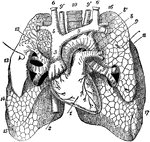Clipart tagged: ‘bronchioles’

Anterior View of the Lungs and Heart
Anterior view of the lungs and heart. Labels: 1, heart; 2, inferior vena cava; 3, superior vena cava;…

Respiratory Mechanism
"The respiratory mechanism consists of the lungs, a series of minute air chambers with a network of…